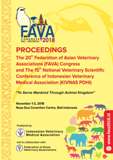PCS-2 Specialized Structured Cardiovascular of Bats Related to Their Ability to Fly
Abstract
Bats have the second largest diversity in mammalian classes after rodentia (Nurfitrianto et al., 2013). Bat population reaches approximately 1100 species (Teeling et.al 2005). In Indonesia there are 205 or 21% of known world bat species (Suyanto 2001). Bats are the only flying mammals. The ability bat to fly is supported by the shape of the extremities and also the adaptation of the cardiovascular organs. Based on empirical studies of cardiovascular was known that cardiac muscle mass is a good indicator for the degree of adaptive specialization of prolonged locomotor activity, in both birds and mammals. Data on cardiovascular muscle morphology and muscles that support flying ability will provide an overview of the behavior, ecology and physiology of certain animals (Bishop 1997).
Several studies have been conducted to study the cardiovascular system of bats. Research on bat hematology profile has been done (Heard and Whittier 1997, Mclaughlin et.al 2007, Wawrocka and Bartonicka 2014, McMichael et al. 2015, Ratnasooriya 2016, Rashid et al, 2016, Rahma et al., 2018). Joseph (1908) says that every animal has a different size and heart shape to each other. This heart size difference is influenced by the size of the body and the high energy required by the animal (Joseph 1908).
Bat's heart rate is known to increase during flight (Thomas and Suthers 1972). This is causes an increase in the rate of metabolism. Writing this paper will discuss about the uniqueness of the bat's heart so that it can support its ability to fly.

